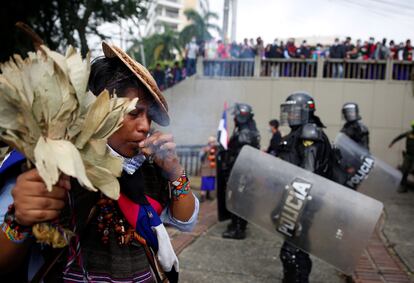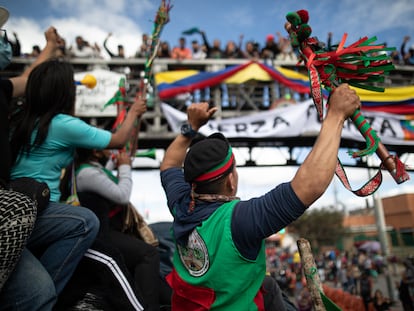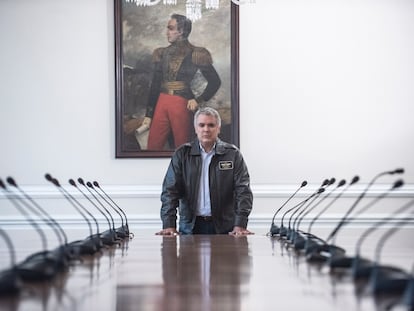Understanding the racism and classism at the heart of Colombia’s protests
The confrontation between armed civilians and indigenous groups in Cali has highlighted unaddressed forms of violence that the state has yet to acknowledge
Although the spark that ignited Colombia’s protests on April 28 was ostensibly tax reform, many are on the streets for reasons that stretch much further back in the country’s history. As the protests continue for a third week, many are asking not “why now?” but “how did it take this long?” according to Óscar Almario García, a historian who teaches at the National University of Colombia.
Classism and racism against indigenous groups are “an open and bleeding wound,” he said in a telephone interview with EL PAÍS. “What we are hearing now are demands that come from centuries of denial and exclusion. The call to recognize distinct forms of racism has been repressed in this country.”
The worst violence of the protests has been registered in Cali, Colombia’s third largest city. And it is here, said Almario García, that one can see the flashpoint between Colombia’s excluded citizens and those who remain more protected by the state. An indigenous minga (a word synonymous with resistance) has blocked roads in the city for days, limiting essential supplies and clashing head-on with Colombians who feel that what is rightfully theirs is under threat.
When indigenous groups approached one of Cali’s richest areas, they were met with live fire, leaving at least nine injured. Tensions in Cali were “a bomb about to explode,” said Almario García, who has written a book about the Cauca Valley region where Cali sits, and where he was born. “It is not difficult to understand why the struggle of indigenous people against the established powers is a struggle that has gone on for 200 years: there have been 200 years of resistance by indigenous people and those of African descent,” said Almario García.
Myriam Jimeno, an anthropologist and writer, said that what happened in Cali and the protests more generally has exposed deep-rooted problems that everyday life has obscured. “Colombia has at least two million indigenous people, 104 peoples scattered throughout the country, and when they speak out and demand what is rightfully theirs, they make people uncomfortable,” she said. In the Cauca Valley, where just over 300,000 indigenous people live, land conflicts continue to have lethal consequences, even with the FARC’s departure from the scene.
According to Indepaz, a peace-building organization, 269 indigenous leaders have been assassinated since 2016, 167 of them during President Iván Duque’s leadership (data to June 2020). Meanwhile, there are at least 39 indigenous peoples on the verge of extinction.

Sometimes the rhetoric against indigenous people is plain enough: Omar Yepes Alzate, the director of Colombia’s Conservative Party, has said that indigenous people disturb society when they leave their “natural habitat.” The state has done little to investigate the deaths of community leaders in land conflicts or to tackle exclusion, because it does not consider these to be real problems, Jimeno added.
“Racism and classism are mixed. Saying demonstrators are ‘ignorant’ or ‘lazy’ not only ‘others’ them, but also marks out the person calling them these things as superior in a very hierarchical country that divides the population into physical spaces. People in the rich neighborhoods do not know the poor. This happens in education too, as state education, in general, is for the poor,” she said. “This is a violence charged with the fear of the other coming too close, of contact, of them touching what is mine.”
Mauricio Archila, a historian and analyst at the Center for Research and Popular Education, a Colombian think tank focusing on social exclusion, believes structural problems that have historically affected different groups of Colombians have come to light as never before during the protests. “Going back to our historical roots as a [Spanish] colony, the indigenous were despised, the Catholic Church was imposed, and the [Spanish] language was imposed,” said Archila. Class was also a strong factor in many of the protesters’ decisions to take to the streets, he added. Many of those killed by police at the demonstrations are poor or middle-class youths, and branded “vandals.”
“We know how to celebrate diversity in a lot of ways, but it hasn’t been enough,” added Felipe Arias Escobar, a historian and journalist. “Indigenous people are politically, physically and culturally isolated and they are seen as a homogeneous group. There are people who can’t believe they use cellphones and motorcycles… We are the children of a racist nation that feeds off excluding others.”
For Nubia Ruiz, a sociologist who teaches at the Colombia National University, the country’s elites maintain their dominance in times of crisis “with blood and fire.” According to this expert, “they feel their economic interests threatened when indigenous people reclaim their territory, so physical aggression is added to verbal and symbolic aggression.”
For many decades, Colombia was caught up in the conflict with the FARC guerrillas, but with the peace agreement signed in 2016, the deep damage lying underneath that conflict has been laid bare. For Alejandro Cortés-Arbeláez, a political scientist who teaches at Colombia’s Universidad del Bosque, Colombia is experiencing an overdue reality check. “We are an undemocratic country if we think of democracy as something beyond just elections. Decision-making is still top down, and the proof of that is the intellectuals and politicians who were taken by surprise by what is happening,” he said.
Tu suscripción se está usando en otro dispositivo
¿Quieres añadir otro usuario a tu suscripción?
Si continúas leyendo en este dispositivo, no se podrá leer en el otro.
FlechaTu suscripción se está usando en otro dispositivo y solo puedes acceder a EL PAÍS desde un dispositivo a la vez.
Si quieres compartir tu cuenta, cambia tu suscripción a la modalidad Premium, así podrás añadir otro usuario. Cada uno accederá con su propia cuenta de email, lo que os permitirá personalizar vuestra experiencia en EL PAÍS.
¿Tienes una suscripción de empresa? Accede aquí para contratar más cuentas.
En el caso de no saber quién está usando tu cuenta, te recomendamos cambiar tu contraseña aquí.
Si decides continuar compartiendo tu cuenta, este mensaje se mostrará en tu dispositivo y en el de la otra persona que está usando tu cuenta de forma indefinida, afectando a tu experiencia de lectura. Puedes consultar aquí los términos y condiciones de la suscripción digital.
More information
Archived In
Últimas noticias
Tiger Woods turns 50: Will he continue playing on the PGA Tour or take a back seat?
The surreal journey of James Nnaji, the Barcelona youth player selected in the NBA Draft who ended up in the NCAA
Trump claims peace in Ukraine is near, but Moscow suggests otherwise
A survivor’s account of the Interoceanic Train accident: ‘We were scared because of the speed on the curve’
Most viewed
- Oona Chaplin: ‘I told James Cameron that I was living in a treehouse and starting a permaculture project with a friend’
- Reinhard Genzel, Nobel laureate in physics: ‘One-minute videos will never give you the truth’
- Why the price of coffee has skyrocketed: from Brazilian plantations to specialty coffee houses
- Pablo Escobar’s hippos: A serious environmental problem, 40 years on
- Chevy Chase, the beloved comedian who was a monster off camera: ‘Not everyone hated him, just the people who’ve worked with him’












































